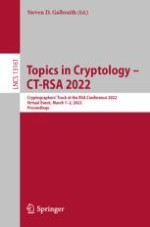2022 | Book
Topics in Cryptology – CT-RSA 2022
Cryptographers’ Track at the RSA Conference 2022, Virtual Event, March 1–2, 2022, Proceedings
Editor: Steven D. Galbraith
Publisher: Springer International Publishing
Book Series : Lecture Notes in Computer Science
